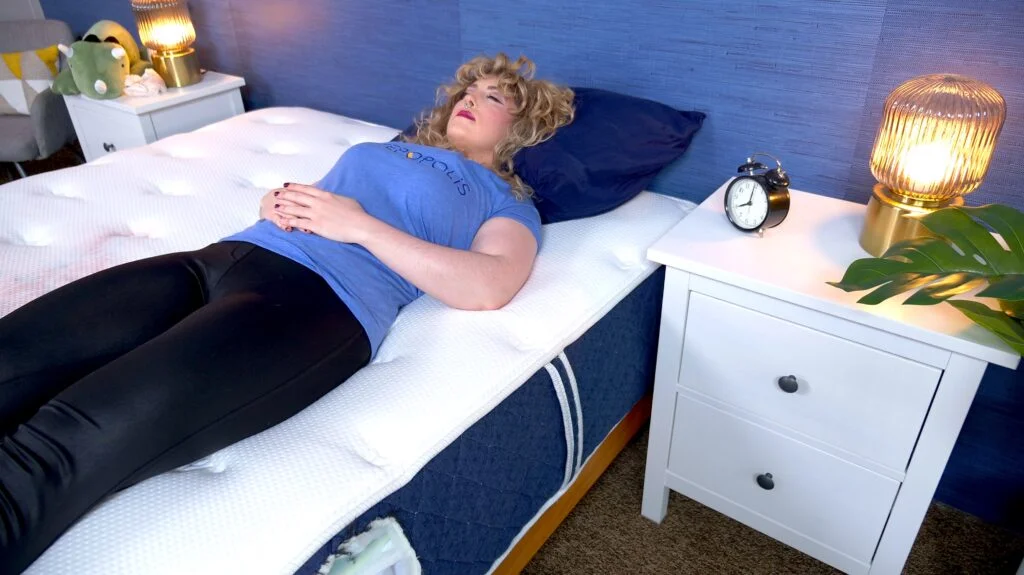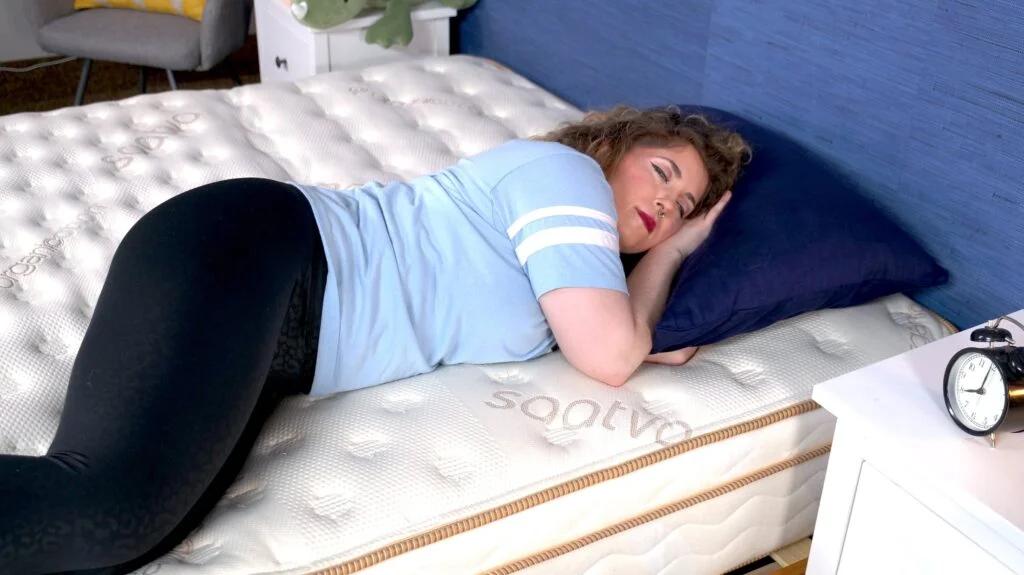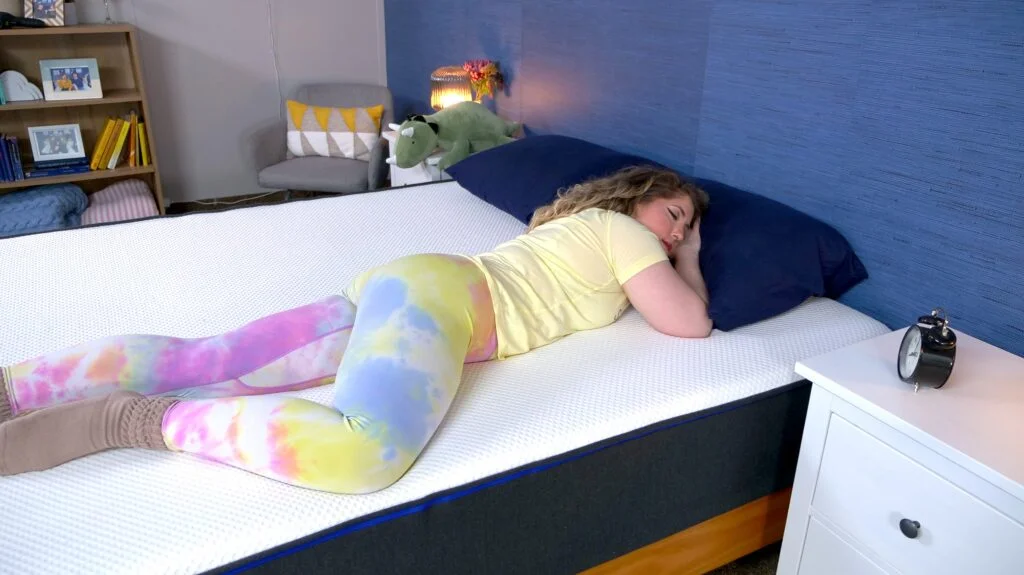Shopping for a mattress is objectively pretty overwhelming, but we prefer to view it as an exciting opportunity to improve your sleep health. And when you consider factors like sleeping position, firmness preference, budget, whether you share the bed with a partner or pet or more personal factors, like chronic pain, the process becomes a lot simpler.
We use these factors as inputs in our mattress quiz, which is designed to help you narrow down the options and remove the roadblocks between you and your ideal mattress.
How to Use Our Mattress Quiz
Our mattress quiz is really simple, and only takes a couple of minutes at most. Answer the prompts in the module below, and our mattress database built by our expert review team will recommend mattresses that fit your requirements.
You will then be able to filter your results even more, or change your preferences to expand or narrow your search. All you need to do to get started is to answer the first prompt in the section below.
Factors for Deciding What Mattress Is Best for You
When we’re reviewing mattresses, our staff of Certified Sleep Science Coaches is constantly considering what mattresses are best for certain types of sleepers. There is a lot of nuance to this evaluation, but it’s certainly not rocket science.
Here, we’ll pull back the curtain a bit and show you what factors to consider when selecting your next mattress, including sleeping position, body type, budget, and more.
Sleeping Position
Your sleeping position plays a huge role in what types of mattresses to consider. Most folks do switch positions throughout the night, so it’s best to consider your primary sleeping position or positions.
And if you’re reading this thinking “I bow to no sleeping position,” then you’re probably what we call a combination sleeper. Combination sleepers change positions throughout the night, whether from side-to-stomach, back-to-side or side-to-back-to-stomach-to-side. I’m sure at this point you get the idea.
If you’re not sure or haven’t considered your sleeping position, try to pay close attention in the coming nights before making your mattress purchase. You’ll be thankful you did.
Below, we’ll get how specific sleeping positions should factor into your mattress decision.
Back Sleepers

- Back sleepers require a mixture of comfort and support. They usually need a bed that has enough cushioning at the lumbar region to give them pressure relief, while also being supportive enough to give them a slight “lift” that helps keep their spine neutrally aligned. We usually recommend that back sleepers opt for a medium-firm to firm mattress. They tend to do well on hybrid mattresses and some memory foam models.
Side Sleepers

- Side sleepers put the most pressure on their shoulders and hips, and need a lot of contouring in those areas. We usually steer them toward a soft- to medium-soft mattress. They tend to do well on memory foam beds and some hybrid models.
Stomach Sleepers

- Of all the sleeping positions, stomach sleepers put the most pressure on a mattress and need a bed that’s firm and supportive enough. That way, their hips stay lifted and aligned with their shoulders, which helps prevent back pain. They tend to do well on firmer hybrid and innerspring mattresses.
Combination Sleepers
- Combination sleepers are folks who switch sleeping positions throughout the night. They can be comfortable on a variety of firmness levels, but usually do best on a mattress with springs in the construction that give them enough responsiveness to easily change positions (so, hybrids and innersprings)
Body Type and Weight
When discussing weight, we use the categories light, average, and heavy to more easily classify sleepers. This allows us to recommend beds that perform best for their body type. It’s worth noting that most mattresses are designed for the group we call “average” (130 to 250 pounds). In general, lighter sleepers don’t require as much firmness and support as heavy sleepers. Let’s break down what types of beds might be best for different body weights.
Light Sleepers (under 130 pounds)
The less you weigh, the firmer a mattress feels. With that in mind, we usually steer lightweight sleepers toward soft to medium-firm beds. Firm and extra-firm mattresses probably won’t give them the pressure relief they need.
Average Sleepers (130–250 pounds)
Because most mattresses were designed for their weight range, average weight sleepers tend to have the most options. There aren’t really any mattress types that we don’t recommend for this group.
Heavy Sleepers (over 250 pounds)
Heavy sleepers put the most pressure on a mattress and, on the opposite end from light sleepers, tend to experience beds as being softer than other folks. We recommend they opt for a firmer mattress so they can get the right amount of support. Something with springs is usually a good bet. Also, several brands design mattresses specifically with larger folks in mind, so these are always a safe bet. These include the Titan Plus, WinkBed Plus, and Saatva HD.
Firmness

We rate firmness on a scale from 1 to 10, where 1 is the softest (think a pile of feathers) and 10 is the firmest (think a wooden board). Obviously, most mattresses fall between these two extremes. We should also note that because firmness is objective, we usually tally the scores of several different people, then come up with an average score for the reader. Here’s how we classify the different firmness categories using the scale.
- 1–5: soft
- 5.5–6: medium soft
- 6.5: the industry standard for medium firm
- 7–7.5: firm
- 8–10: very firm
Price and Budget
While there’s no hard and fast rule as to what constitutes a budget mattress or a luxury mattress, you should definitely consider how much you’re willing to spend on a new bed before making a purchase. Here are some roundups that feature mattresses of all different price points.
- Best Mattresses for the Money
- Best Cheap Mattresses
- Best Mattresses Under $1,000
- Best Luxury Mattresses
Health and Lifestyle Concerns
Finally, when purchasing a new mattress, you’ll also want to consider any health or lifestyle factors that might affect your decision and what kind of bed you need. Here are just a few.
Pain and Age
If you’re an older person with mobility issues, or just someone who struggles with chronic pain, you’ll want to keep your mattress’s construction, firmness, and feel in mind. For instance, memory foam is a great material for cushioning achy joints. And if you have trouble getting in and out of bed, a more responsive mattress such as a hybrid or innerspring will allow for easier movement.
Couples and Pets
If you share your bed with a partner or a pet, you’re going to need some additional room. If you can afford it, it’s best to go with a queen-size mattress or larger. But there are also some other factors to consider — namely motion transfer and edge support. Motion transfer refers to how much movement ripples across a bed’s surface. A mattress with low motion transfer means you’re less likely to feel your partner (or pet) moving around at night. Memory foam mattresses tend to absorb motion a lot better than hybrids and innersprings.
Edge support refers to how supported you feel while lying near the edge of the mattress. A bed with strong edge support usually means that you and anyone else in bed can use the whole surface without feeling like you’re going to fall off. Hybrid and innerspring mattresses tend to have stronger edge support than foam beds, and some models even have extra coils at the perimeter for reinforcement.
Cooling


Temperature regulation is definitely an important consideration when choosing a mattress. Maybe you don’t have air conditioning or live in a warmer part of the world. Or maybe you just sleep especially hot. Either way, if keeping a low temperature is important, you may want to consider a cooling mattress.
As a rule, beds with springs in the construction tend to sleep cooler than all-foam mattresses, as the springs leave more room for air to flow through the bed. Some mattresses are also specifically designed for cooling and have added cooling technology such as gel or copper infusions and cooling fabrics like Tencel and phase change material.
Mattress Quiz FAQs
How does the mattress quiz work?
Our mattress quiz prompts you to answer simple questions about your sleep preferences, body type, and budget. It then automatically provides a list of mattresses that fit your individual criteria. These recommendations are pulled from a database of information collected by our mattress-testing team through years of hands-on mattress reviews at the Sleepopolis testing lab.
What is the best way to test a mattress?
The best way to test a mattress is to sleep on it. Many brands offer a trial period where customers can try the mattress out at home before deciding if it’s the right fit for them. These trial periods range from a few months up to a year.
Our testing team puts each mattress we review through a series of tests to evaluate important mattress qualities like firmness, pressure relief, cooling, responsiveness, motion transfer, sinkage, edge support, and more. If you want to learn more about how we test mattresses, check out our review methodology page.
How do I know what mattress is right for me?
There are many factors to consider when evaluating if a mattress is a good fit for you. Your sleeping position, body type, budget, and preferences around firmness, materials, and cooling should all be accounted for when evaluating mattresses. If you want a deeper dive on this process, you should read our guide on how to choose a mattress.

























